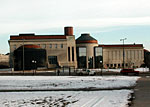Higher education is big winner in bonding derby
By Laura McCallum
Minnesota Public Radio
January 28, 2002
|
| RealAudio |
Minnesota lawmakers will be assembling a package of public works projects. Gov. Ventura is recommending $845 million in projects, and some legislators want to borrow even more.
| |
|
|
|
||
In non-budget setting years, the Legislature focuses on a capital investments package. It's commonly called the bonding bill, because the vast majority of projects get funded with money borrowed through bond sales. Over the past two decades, the biggest chunk of this funding has gone to higher education.
Legislators approved $1.6 billion worth of building projects at colleges and universities around the state over the past 20 years. Adjusted for inflation, that's over $2 billion. The 34 institutions that make up the MnSCU system got the most money, followed by the University of Minnesota.
U of M Chief Financial Officer Richard Pfutzenreuter worked on bonding bills for more than 20 years as a House staffer. He says it's not surprising that higher education tops the list.
"Both MnSCU and the university, of course, are state-funded institutions. And for these academic buildings that both of these institutions need, the ability for those institutions to levy the debt and build them alone would be impossible," he says.
Ranking behind higher education, the second-largest recipient of capital investment money is the state Department of Transportation. MnDOT has received about a $500 million since 1981, much of it for bridges and maintenance buildings.
The Department of Administration, which maintains many state buildings, is a close third, followed by the DNR and education.
The capital investment chairmen in the House and Senate looked at MPR's analysis, and largely agreed with the top priorities. But the chair of the House Capital Investment Committee - Rep. Jim Knoblach, R-St. Cloud - says the state should have put more bonding money into roads.
"Part of the reason is, we've had this philosophy for the last 20 years or so of just paying cash, and I frankly think that's silly. We bond to build new buildings at colleges, we bond for state parks, we bond for new prisons; those are capital assets. A road is a capital asset too. It's going to be around for many, many, years," Knoblach says.
| |
|
|
|
||
Knoblach also takes issue with the amount of bonding money that has gone into transit. The biggest single bonding project of the past 20 years is the Hiawatha light-rail line that will connect downtown Minneapolis with the airport and Mall of America. It has received a total of $100 million in bonding money.
Many Republicans consider light rail a waste of money that will do little to decrease traffic congestion.
Transportation Commissioner Elwyn Tinklenberg says the light rail line is cost-effective at $100 million. "While that sounds like a lot of money, in transportation terms in the metropolitan area, it's not. Interstate 494 in Bloomington is going to be something in the neighborhood of $750 to $800 million. The right of way in Bloomington is $200 million alone," Tinklenberg says.
Other big-ticket projects are the Rush City prison, the expansion of the Minneapolis Convention Center, the Revenue Department building and the Minnesota History Center.
Gov. Ventura is proposing an even bigger transit project this year; $120 million for a commuter rail line between St. Cloud and Minneapolis. House and Senate leaders haven't committed to supporting the request.
Senate Capital Investment Committee Chairman Keith Langseth, a DFLer from Glyndon, is taking a cautious approach, as he did with light rail. "There was a grand scheme of $4 billion worth of light rail around. That, of course, scared me as a country boy. And I said, 'Pick out a good corridor, do one, get it up and running, let's see how it goes,'" according to Langseth.
Langseth says the Senate's bonding bill will come in higher than the governor's recommendation; probably just under $1 billion. He says it will put more money into higher education, and include some local and regional projects that weren't recommended by Ventura.
House Republicans aren't saying whether they'll want to borrow as much as the governor. Rep. Knoblach says the bonding bill is typically one of the toughest bills to pass. It requires a 60-percent vote in both bodies, and is certain to spark debate over whether the state should borrow more or less during a time of budget shortfall.
More from MPR

